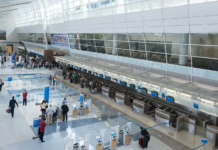Three major technology failures in four months have cost the carrier at least $43 million, with passenger disruptions mounting and stock prices falling.
Alaska Airlines has absorbed more than $40 million in losses from three separate technology outages since July, a financial blow that has hammered the carrier’s earnings and raised questions about the reliability of its computer systems.
The most recent disruption struck Wednesday when a global Microsoft Azure platform failure knocked offline key services for Alaska Airlines and Hawaiian Airlines, preventing passengers from checking in online and temporarily shutting down both carriers’ websites and mobile applications. The outage affected Microsoft services worldwide, including Office 365 and other platforms beyond aviation.
Passengers found themselves unable to access online check-in systems and were forced to queue at airport counters, creating massive lines that caused many travelers to miss their flights. Alaska Airlines deployed backup infrastructure to restore limited functionality while Microsoft worked to resolve the broader platform issues.
“Our teams worked quickly to stand up our backup infrastructure,” the airline said in a statement issued at 3:50 p.m. Pacific Time. “We are bringing impacted systems back online this afternoon, with other services set to resume once Microsoft resolves the issue from its end.”
Wednesday’s incident marks the third major technology failure to hit Alaska Airlines this year. In July, a hardware malfunction at one of the carrier’s data centers grounded the fleet for three hours, triggering four days of flight delays and roughly 200 cancellations at a cost of $17 million.
The October 23 outage proved more severe. A failure at Alaska’s primary data center grounded aircraft for eight hours, resulting in approximately 400 flight cancellations and disrupting travel for more than 50,000 passengers. That incident cost the airline an estimated $26 million, with normal operations resuming after two days.
Combined, the July and October outages have cost Alaska Airlines roughly $43 million, a figure expected to rise with the latest incident, though the Microsoft-related disruption appears to have had less operational impact than the previous two failures.
The financial toll extends beyond immediate operational costs. Alaska Airlines must compensate affected passengers, provide hotel accommodations, and rebook travelers on other carriers when necessary. The repeated disruptions have also pressured the company’s stock price and eaten into quarterly earnings.
Alaska reportedly brought in outside consultants to overhaul its technology systems and prevent future failures. While it remains unclear whether the July and October incidents were connected, both stemmed from the airline’s own infrastructure problems rather than third-party issues.
The technology problems now affect both Alaska Airlines and Hawaiian Airlines following their merger, expanding the geographic footprint of any disruption. Alaska Airlines operates major hubs in Seattle, Anchorage, Los Angeles, Portland, San Diego and San Francisco, while Hawaiian Airlines maintains hubs in Honolulu and Kahului. When systems fail, aircraft must be rerouted and flight crews can time out, requiring replacements across this combined network.
For airlines, operational reliability ranks among the most critical factors passengers consider when choosing a carrier. Repeated technology failures risk damaging Alaska Airlines’ reputation for dependability, potentially affecting the carrier’s ability to attract customers or maintain premium fares in an increasingly competitive market.
Alaska Airlines did not immediately respond to requests for comment on the latest outage or its broader technology infrastructure plans.

Key Takeaways
- Alaska Airlines has incurred at least $43 million in losses from three separate IT outages since July 2025, with costs expected to rise from the most recent incident.
- The October 23 outage caused approximately 400 flight cancellations and disrupted more than 50,000 passengers during an eight-hour ground stop.
- Wednesday’s Microsoft Azure platform failure affected both Alaska Airlines and Hawaiian Airlines, forcing passengers to check in at airport counters and temporarily disabling websites and mobile apps.
- The carrier has hired outside consultants to revise its technology infrastructure, though the financial and reputational damage continues to mount with each successive failure.








